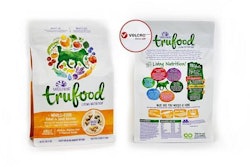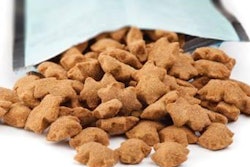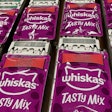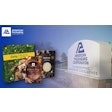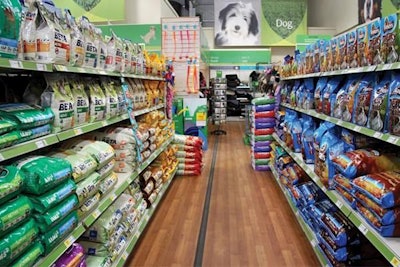
Good packaging engages the consumer on every possible level, according to Stefan Hartung, executive creative director for Kick, which focuses on packaging design. “Great design elevates every touchpoint to a delightful experience—creating lasting relationships.” With more pet food options on store shelves than ever before, and with consumers increasingly savvy about what they’re feeding their pets, it’s vital for pet food manufacturers to make sure they stand out. The best way to do that is marketing, and the most visible form of marketing is the very packaging consumers must look at before they buy a product.
“The pet food packaging industry has come a long way from the days of just serving as a vessel for conveyance of the food—it is now a vehicle for on-shelf advertisement,” said Dave Long, North America pet market director; Loic Sebileau, global pet coordinator; and Chris Swalm, marketing manager, all with Coveris. “This advertisement is not only of the brand message, but also the pet food company’s vision and direction. The package plays a major role in distinguishing the brands on the shelves and at home. One of the best opportunities for pet food producers to make the food attractive to the consumer is to play with packaging styles, changing colors and decorative aspects, and offering improved features. In these ways, the brand can customize the message.”
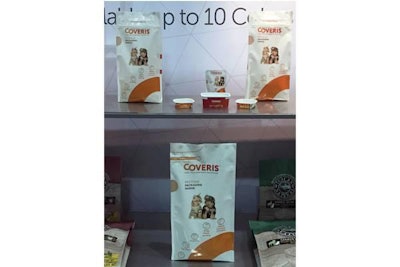
Courtesy Coveris
In today’s pet food market, multiple needs and desires of both manufacturers and consumers must be met when it comes to packaging. Coveris has responded to these needs with a variety of substrate options (paper, plastic, hybrids and woven polypropylene) and continues to invest in the latest printing and converting technologies.
Appealing to the emotional aspect of pet food buying is part of that marketing. “Many times, food packaging is the first introduction of your product to a potential customer, so their perception of your brand is part of the decision-making process on whether or not they will try or purchase your product,” said William Schueddig, director of marketing for PBFY Packaging. “Using colors and imagery will affect the emotions of the consumer, but customers need to connect emotionally to your packaging. You never see snarling dogs or hissing cats on packaging. Pets are shown running, eating or looking at you with happy expressions. That same emotion is what pet owners want to feel when they give a product to their pet.”
As such, packaging can be used to convey subtle marketing ideas that consumers are looking for. Unique-shaped packaging can cue a premium product while driving shelf and merchandizing appeal, according to Angela Adams, director of innovative packaging solutions at Sonoco. Clear packaging windows can communicate trust, authenticity, freshness, quality and a healthy or more nutritious product. Reliable resealing technology promotes freshness and product integrity while delivering convenience.
Functionality in pet food packaging has taken on a more complex meaning in recent years—not only must it speak to ease-of-use for potential customers, but manufacturers are now eyeing the space options provided by innovative packaging design as potential for their branding messages. “We’re seeing a trend among pet food manufacturers towards the use of square-bottom bags, which can be printed on six sides including the bottom,” said Kevin Young, president, consumer goods packaging, at Mondi North America. “This gives petfood manufacturers 360 degrees of real estate to present their logos and brand promotions. Smaller square bags will stand upright on shelves, while larger ones can lay horizontally on pallets in big box stores. Consumers can see the brand from any angle.”
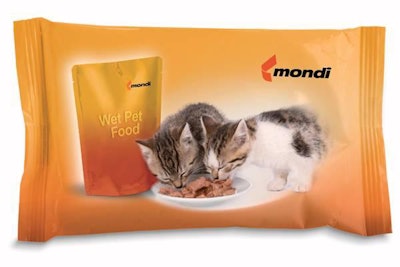
Courtesy Mondi North America
For wet pet food, manufacturers are going to retort packaging that helps ensure long-term freshness and shelf life—both key factors in getting a potential consumer to consider their product.
For many companies, the right packaging, such as a flat-bottom bag, complements the marketing campaign the brand has invested in, according to Mark Liberman, vice president of sales and marketing for Peel Plastic Products Limited. “There is an expectation from the consumer today that when they purchase a premium food they will have a premium experience from the first feeding to the last,” he said. “The flat-bottom side-gusset package offers the brand owner the maximum of number panels to share the brand’s message, important feeding tips and other pertinent information, and provides brand recognition from any number of display positions.”
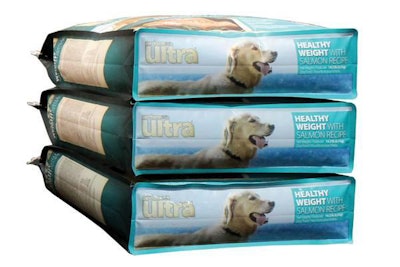
Courtesy Peel Plastic Products Limited
Flat-bottom pet food bags provide extra panels of potential branding space, no matter how they’re displayed. This can provide an advantage to manufacturers who want to make their product stand out on store shelves.
Convenience, however, is the trump card of pet food packaging, combining the desired functionality manufacturers require for their products with the ease-of-use experience consumers crave. A product packaged in a resealable bag, for example, can nearly serve as its own branding pitch. “Branding, design presentation and product differentiation are all important aspects in the pet food packaging market,” said APLIX Inc. “By bringing together these key elements, pet food companies are able to provide innovative and premium products that respond to what consumers are looking for in a package. Pet food market trends are continuously shifting towards innovative packaging solutions to enhance the consumers’ experience.”
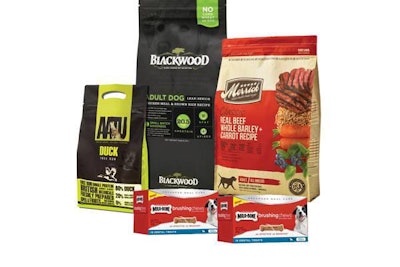
Courtesy APLIX
Easy-Lock by APLIX is a hook-to-hook closure designed for flexible packaging. APLIX’s closure was developed with simplicity and functionality in mind, and provides an audible feedback when opening and closing to let consumers know their package is sealed.
Closure systems are a primary way pet food packagers promote convenience for manufacturers’ products. “Improved closure systems have become even more important as pets are more humanized,” said Glen Treliving, North American sales for Takigawa Corporation. “The pet’s food is more often stored in a cupboard with human food, so better closure systems work much better to keep both odor and freshness inside the package. Packaging with no closure is a problem in these cases that can only be solved by dumping the food into a Tupperware-type container, which then removes the brand from the food.”
Demand for plastic pouches is expected to increase 8.3% per year through 2018, according to a study conducted by The Freedonia Group Inc. “Conventional pet food is forecast to grow 3% per year,” said Young. “So manufacturers are in need of premium packaging, such as pouches, often with features that make for easy opening and closing, carrying and handling, to properly reflect the product’s quality.” Among those features are specialized closures. “Maintaining freshness is critical to consumers,” said Young. “Years ago you bought a bag, tore it open and poured out some dog food. Now you have zip lock, Velcro, easy sliders and more to help seal in freshness. For wet petfood, manufacturers are going to retort packaging that helps ensure long-term freshness and shelf life.”
Pet food packaging is expected to continue to evolve with these key trends in mind, according to the industry. “As technology improves, so will the convenience and functionality of pet food packaging,” said Schueddig. “It will be an interesting journey to see what type of packaging consumers accept for their pets.”
Consumers are always looking for the next big thing, according to Coveris. “Positive changes attract attention in the first moment when a consumer is trying to decide on which product to buy,” said the company. “Standing out on the retail shelf is critical in that moment. Pet food manufacturers are increasingly listening to the feedback of their customers and providing new food science options and visual packaging changes to cater to the ever-changing preferences of that audience.”
And if proper attention isn’t paid to that audience, valuable marketing opportunities might be lost. “I have heard several times, ‘I am not selling a package, I am selling the food inside’,” said Treliving. “If this strategy was effective, we would only be faced with aisles of products in black and white packages. Ask yourself: how many times has a really innovative package launched a product ahead of the competition?”
Packaging, according to Adams, should enable the brand promise and product’s use occasion. Packaging needs to connect with and educate the shopper on shelf or online at the moment of purchase, but it also needs to deliver quality and freshness from first opening through functional storage to using the last treat.
“The packaging solutions provided by converters who are uniquely committed to the pet food industry continue to evolve to emulate or exceed the solutions and trends we see on the human food side of the aisle,” said Liberman. “The most progressive converters are consistently investing in new technology to offer solutions which address brands owners’ needs to stand up and out on shelf, deliver a functional packaging, offer new textures or finishes and most importantly keep the product safe and fresh throughout the supply chain.”
The latest on pet food packaging



